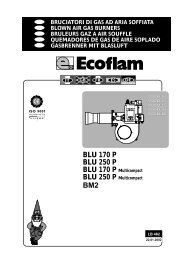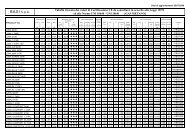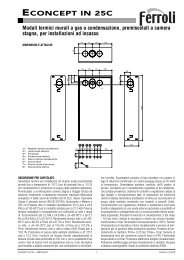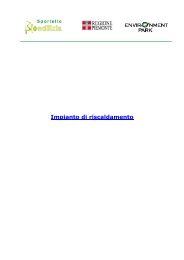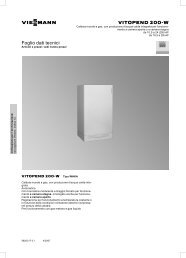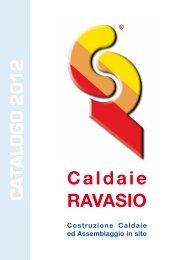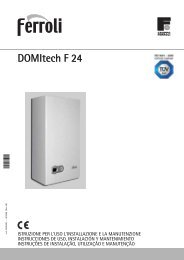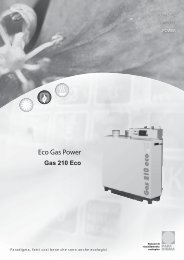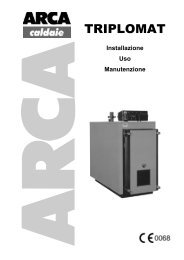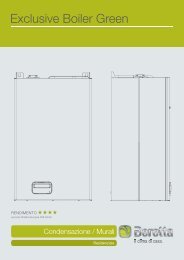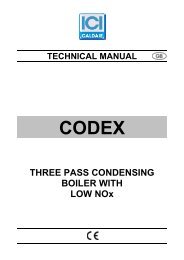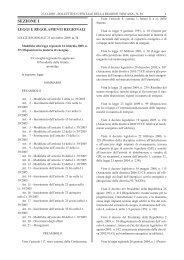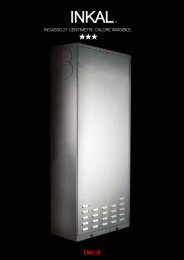aermec idrosplit - Certificazione energetica edifici
aermec idrosplit - Certificazione energetica edifici
aermec idrosplit - Certificazione energetica edifici
You also want an ePaper? Increase the reach of your titles
YUMPU automatically turns print PDFs into web optimized ePapers that Google loves.
CARATTERISTICHE • FEATURES<br />
chi termici di progetto.<br />
Per esempio, per la camera matrimoniale sono sufficienti<br />
1.260 W, mentre il modello FCX 31, alla minima velocità,<br />
alimentato con 250 l/h di acqua a 50 °C (∆t = 30 °C), assicura<br />
2000 W. La portata totale d’acqua è, con queste ipotesi,<br />
pari a 1.200 l/h, corrispondenti a 1,2 m 3 /h.<br />
Conoscendo le caratteristiche del circolatore della caldaia,<br />
si ipotizzi che, con una portata di 1,2 m 3 /h, la prevalenza<br />
utile sia pari a 2,3 m C.A. Tale portata, prima di raggiungere<br />
il circuito utilizzatore, passa attraverso il modulo Idrosplit:<br />
dalla prevalenza a disposizione, allora, bisogna sottrarre le<br />
perdite del modulo Idrosplit. Nel diagramma di tavola 7 si<br />
legge, in corrispondenza di 1.200 l/h, una perdita di carico<br />
pari a circa 0,6 m C.A.<br />
La prevalenza a disposizione a valle del modulo Idrosplit è<br />
dunque pari a 1,7 m C.A.<br />
Il circuito idraulico dovrà essere dimensionato in modo che<br />
le perdite di carico abbiano un valore uguale od inferiore a<br />
questo.<br />
Se le perdite calcolate sono minori di 1,7 m C.A., la portata<br />
totale che si instaura, sicuramente sufficiente, è maggiore di<br />
1.200 l/h; tale portata si ricava in corrispondenza all’incrocio<br />
tra la curva caratteristica dell’impianto e quella della<br />
prevalenza a disposizione.<br />
In caso contrario si dovrà ripetere il procedimento variando<br />
uno o più parametri progettuali (grandezza dei ventilconvettori,<br />
temperatura acqua, diametro delle tubazioni). In caso<br />
(poco probabile) di manifesta insufficienza del circolatore di<br />
serie della caldaia, bisognerà prevederne la sostituzione con<br />
uno avente prevalenza utile maggiore.<br />
VERIFICA DEL FUNZIONAMENTO ESTIVO<br />
Nelle condizioni più gravose si intende far funzionare contemporaneamente<br />
i due ventilconvettori nella zona cucinasoggiorno<br />
durante il giorno, e i due ventilconvettori delle<br />
camere nella notte.<br />
Si tratta allora di avere impegnata contemporaneamente<br />
una potenza frigorifera pari a 3.050 W durante il giorno e<br />
840 + 1.300 = 2.140 W durante il periodo notturno.<br />
È sufficiente quindi l’installazione del modulo ID 31, che<br />
sviluppa, in condizioni nominali, 3.900 W.<br />
Il ventilconvettore del bagno, se lo si desidera, può essere<br />
sempre mantenuto in funzione.<br />
Si deve ora controllare che la portata che si instaura nei vari<br />
ventilconvettori nel funzionamento estivo sia sufficiente ad<br />
assicurare la resa frigorifera desiderata.<br />
Si ipotizzi che il punto di funzionamento invernale corrisponda<br />
alle coordinate (vedi Fig. 2):<br />
Prevalenza - Perdite di carico<br />
8<br />
7<br />
6<br />
5<br />
4<br />
3<br />
2<br />
4<br />
2<br />
Prevalenza invernale<br />
ipotizzata<br />
Punto funzionamento<br />
estivo<br />
1<br />
Punto funzionamento<br />
invernale<br />
0<br />
0 0,4 0,8 1,2 1,6 2<br />
1,37<br />
Portata<br />
Prevalenza = 1,7 e Portata = 1,2 m 3 /h. Allora la caratteristica<br />
resistente del circuito utilizzatore si può rappresentare<br />
con una parabola passante per l’origine e il punto di portata=1,2<br />
m 3 /h (per ragioni di comodità di calcolo conviene<br />
usare i metri cubi e non i litri come unità di misura) e perdite<br />
di carico 1,7 m C.A. Tale parabola è definita da un coeffi-<br />
3<br />
1<br />
Fig. 2<br />
cient, while the FCX 31, at minimum speed, supplied with<br />
250 l/h of water at 50°C (∆t=30°C), ensures 2000 W. The<br />
total water flow is, in this example, 1.200 l/h, which corresponds<br />
to 1.2 m 3 /h.<br />
If the characteristics of the boiler pump are known, with a<br />
flow of 1.2 m 3 /h the available head is 2.3 m W.G.. Before<br />
this flow reaches the distribution circuit, it passes through<br />
the Idrosplit module. From the available head, we must then<br />
subtract the pressure drops of the Idrosplit module. The<br />
chart in table 7 gives, in correspondence to 1.200 l/h, a<br />
pressure drop of about 0.6 m W.G..<br />
The available head downstream to the Idrosplit module is<br />
therefore 1.7 m W.G..<br />
The hydraulic circuit must be sized to make the pressure<br />
drops equal or lower to this value.<br />
If the pressure drops calculated are less than 1.7 m W.G.,<br />
the total flow attained is definitely sufficient, being over<br />
1.200 l/h. This flow is obtained from the intersection<br />
between the curve of the plant and that of the available<br />
head.<br />
If this is not the case, the procedure must be repeated<br />
varying one or more of the design parameters (fancoil sizes,<br />
water temperature, pipe diameter). In the case (very<br />
unlikely) of substantial insufficiency of the standard boiler<br />
pump, it must be replaced with one having a higher available<br />
head.<br />
CHECKING SUMMER OPERATION<br />
In the worst conditions two fancoils will be operated simultaneously<br />
in the kitchen-living room during the day, and the<br />
two fancoils in the bedrooms during the night.<br />
So there is a simultaneous commitment of 3.050 W cooling<br />
capacity during the day and 840 + 1.300 = 2.140 W during<br />
the night.<br />
It is therefore sufficient to install a ID 31 module, which<br />
develops 3.900 W, in nominal conditions.<br />
The fancoil in the bathroom, if desired, can be kept running<br />
continuously.<br />
Now control that the flow attained in the various fancoils in<br />
summer operation is enough to guarantee the required cooling<br />
capacity.<br />
Let us suppose that the winter operating point corresponds<br />
to the co-ordinates (see Fig. 2):<br />
Pressure - Pressure drops<br />
8<br />
7<br />
6<br />
5<br />
4<br />
3<br />
2<br />
1<br />
2<br />
Assumed winter<br />
pressure head<br />
4<br />
Cooling mode point<br />
0<br />
0 0,4 0,8 1,2 1,6 2<br />
1,37 Water flow<br />
Head = 1.7 and Flow = 1.2 m 3 /h. So the resistance pattern<br />
of the distribution circuit can be represented by a parabola<br />
passing through the origin and the point flow=1.2 m 3 /h (for<br />
ease of calculation it is best to use cubic metres instead of<br />
litres as the unit measure) and pressure drop 1.7 m W.G..<br />
This parabola is defined by the coefficient<br />
k=1.7÷(1.2) 2 =1.18 (curve 1).<br />
3<br />
1<br />
Heating mode point<br />
Fig. 2<br />
18



